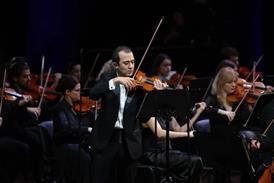From J.S. Bach, to Schumann, Joni Mitchell and Ariana Grande, the violinist outlines how a varied programme of works provides the foundation for a new album

Discover more Featured Stories like this in The Strad Playing Hub
Shifting Ground is my love letter to the music of J.S. Bach, filtered through a 21st-century lens. Interweaving movements of Bach’s music with new commissions, my own arrangements for violin alone, and recent pieces with electronics, the programme traverses eras and soundscapes, exploring the violin in all possible ways. Shifting Ground is designed to be a continuous set, with each piece flowing, morphing, sometimes even crashing into one another. The album is a companion to the live version of Shifting Ground, which I play as a staged violin recital featuring immersive video by the multimedia artist Xuan.
The album begins with the first movement of Bach’s Sonatas and Partitas, the Adagio from the G minor Sonata. The very first chord of the piece is, to me, a perfect introduction to the violin: the simplest and most open four-note chord from which all else springs. From that simplicity, Bach develops the most fantastical introductory movement that feels darkly virtuosic, a hint of what’s to come. That virtuosity is continued in my arrangement of Schumann’s song Widmung, a windswept and exalted expression of pure love.
Two pieces on the album are ones I commissioned with the help of the Borletti-Buitoni Trust, including Angélica Negrón’s The Violinist, a narrated short story (written and read by comedian Ana Fabrega) set to glitchy and psychedelic music that’s at once earthbound and ethereal. The Violinist tells the story of Ana’s nightmare as she dreams she has to play the Brahms Concerto with the New York Philharmonic, but doesn’t know how to play the violin. We’ve all had these kinds of nightmares, which makes this piece that much more engaging and relatable. I continue to be in awe of Angélica’s creative inner world, and how she took Ana’s text and sculpted such a rich palette of sounds around it. I hope you’ll love the humor and beauty in this piece as much as I do.
A set of Matteis (whom I like to think of as Bach’s funkier contemporary), Ariana Grande and Joni Mitchell (two more of my arrangements), and some of my favourite movements of Bach follow. Joni Mitchell, one of the icons of our time, is also one of my mother’s favourite artists, so this arrangement of Blue feels extra special. Ariana Grande’s thank u, next is just such a great song, and I loved finding a way to incorporate it into this album.
Bach’s Tempo di Borea and its Double are two of the most unhinged and visceral movements in the Sonatas and Partitas. I love the second half of these movements, where Bach goes on the wildest tangents and can’t restrain his emotion before reining himself back in for the final cadence. After that, Eve Beglarian’s undulating, meditative Well-Spent employs an arpeggiated violin technique used often by Bach. Her manipulation of the track in this piece, a slowed down and distorted pre-existing recording of a tune by the blues singer Muddy Waters, is hypnotic and trippy. The violin line is a repeated chord progression, which harkens back to Bach.
This leads to a meditative set featuring the other piece I commissioned for this project, Hikari by the New Zealand composer Salina Fisher. I heard Salina’s music years ago and instantly fell in love with her sincere and poetic writing. Hikari, which means light in Japanese, beautifully melds Baroque-inspired violin writing with Salina’s distinctive voice and natural sense of pacing and spaciousness.
Matthew Burtner’s Elegy is a heartbreaking ode to the Muir Glacier, which places an aching violin melody on top of a field recording of the swiftly melting glacier, which disappeared in 2009 due to climate change. Elegy reminds us of the fragility of all that exists around us, a fragility which is echoed in the final piece on the album, Bach’s towering Chaconne. I was introduced to the Chaconne when I was ten years old by my then-teacher Jenny Rudin, and every time I make my way through it I feel a part of her resonate within my soul. Somehow, after all that we’ve heard on the album, the Chaconne is at once familiar and uncharted territory, its vast scope and deep emotional landscape providing a link between the past and present.
The title Shifting Ground is a reference to the heart of all Baroque music—the ground bass—upon which variations are built, and whose omnipresence in music symbolises Bach’s enduring legacy.
Shifting Ground will be released on 7 June 2024 on Bright Shiny Things
Read: Borletti-Buitoni Trust announces awards and fellowships for 2024
Read: Concert review: Alexi Kenney (violin) Daniel Müller-Schott (cello) Francesco Piemontesi (piano)
Read more Featured Stories like this in The Strad Playing Hub
The number one source for playing and teaching books, guides, CDs, calendars and back issues of the magazine.
In The Best of Technique you’ll discover the top playing tips of the world’s leading string players and teachers. It’s packed full of exercises for students, plus examples from the standard repertoire to show you how to integrate the technique into your playing.
The Strad’s Masterclass series brings together the finest string players with some of the greatest string works ever written. Always one of our most popular sections, Masterclass has been an invaluable aid to aspiring soloists, chamber musicians and string teachers since the 1990s.
American collector David L. Fulton amassed one of the 20th century’s finest collections of stringed instruments. This year’s calendar pays tribute to some of these priceless treasures, including Yehudi Menuhin’s celebrated ‘Lord Wilton’ Guarneri, the Carlo Bergonzi once played by Fritz Kreisler, and four instruments by Antonio Stradivari.






































No comments yet